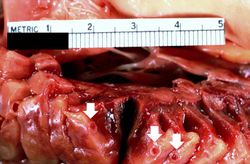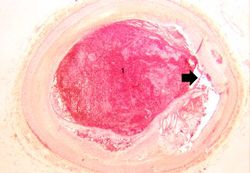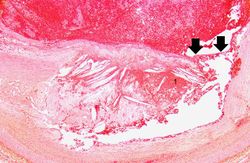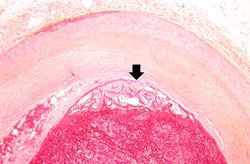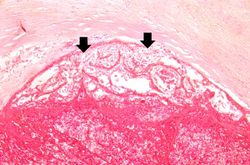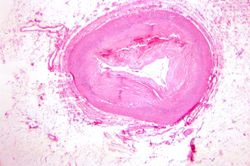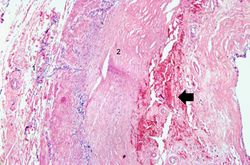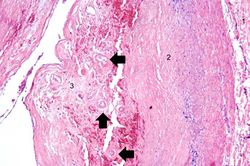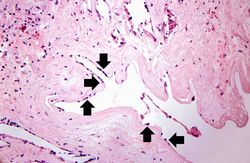IPLab:Lab 4:Thrombosis
Clinical Summary[edit]
This 83-year-old white male was admitted with the chief complaint of chest pain. He had been awakened the previous night with dull chest pain which was retrosternal and radiated through to his back. The pain was associated with sweating, nausea, and vomiting and could not be relieved by antacids. Nitroglycerin gave prompt relief. Following admission he developed cardiac arrhythmias. His AST was found to be 130 IU/L. In the early morning of the day after admission, he developed severe epigastric pain and several episodes of tachycardia (150-160 beats per minute) and later cardiac standstill. He expired less than a day after admission. There was a history of hypertension and diabetes.
Autopsy Findings[edit]
The heart weighed 500 grams. There was massive acute myocardial infarction (about 2 days old) involving the posterior left ventricle, interventricular septum, and right ventricle from apex to base. The infarct was transmural, and there was a small rupture in the soft infarcted area at the apex. There were 1200 mL of blood within the right pleural cavity, probably secondary to this rupture. The coronary arteries showed moderate to severe atherosclerosis throughout the coronary tree.
Images[edit]
In this low-power photomicrograph of another coronary artery from this patient, a mural thrombus has undergone re-organization. The mural thrombus has been invaded by the in-growth of fibroblasts and small blood vessels from the wall of the artery. The thrombotic material has been phagocytosed and removed by macrophages and is replaced by fibrous connective tissue and blood vessels. This re-organized thrombus still compromises the lumen of this vessel.
This is a higher-power photomicrograph of the vessel wall. The adventitia (1) and the media (2) contain inflammatory cells. The recanalized portion of the vessel is composed of fibrous connective tissue and contains numerous small blood vessels. There is a small area of hemorrhage (arrow) in the central portion of this image.
Study Questions[edit]
- What is the source for the fibroblasts and endothelial cells that are present in organizing thrombi?
| |||||
Arrhythmias are abnormal heart rhythms.
Myocardial infarction is necrosis of myocardial tissue which occurs as a result of a deprivation of blood supply, and thus oxygen, to the heart tissue. Blockage of blood supply to the myocardium is caused by occlusion of a coronary artery.
A thrombus is a solid mass resulting from the aggregation of blood constituents within the vascular system.
Mural thrombosis is the formation of multiple thrombi along an injured endocardial wall.
Recanalization is the process of the forming of channels through an organized thrombus so that blood flow is restored.
An occlusion is a blockage.
